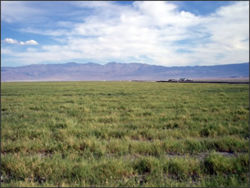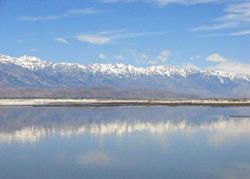User:Milton Beychok/Sandbox
In the past, the Owens Lake dry bed area was characterized as being the largest single source of PM10 (particulate matter less than 10 microns in size) in the United States by the Great Basin Unified Air Pollution Control District (GBUAPCD)[1][2]. That characterization was based on an approximate, unscientific estimate made in about 1986 that the annual PM10 emissions were 300,000 tons.[3] Subsequently, the GBUAPCD monitored and scientifically tested the PM10 emissions over a long period, including daily measurements from the period of July 2000 to 2001, and determined the annual PM10 emissions were only 79,000 tons for that year-long test period.[4] That is equivalent to an average of 217 tons per day. During that test period, a single peak daily value of 7,200 tons was encountered.
During the 1980s and the early 1990s, the U.S. Environmental Protection Agency (U.S. EPA) had designated the Owens Lake area as having not attained the National Ambient Air Quality Standards (NAAQS) for PM10. The wind-blown sand and PM10 air pollution affected approximately 40,000 residents living near Owens Lake. Regionally the blowing sand and dust also affected U.S. Forest Service employees and the U.S. Navy's air weapons station located at nearby China Lake.[5] During those same years, nearby residents in Keeler, California reportedly were exposed to 25 unhealthful days a year while residents in the town of Ridgecrest, California experienced 10 unhealthful days per year due to the PM10 air pollution. An emergency physician at the Ridgecrest Community Hospital was reported as saying "When we see the white cloud headed down through the pass, the ER and doctors' offices fill up with people who suddenly got worse. It's a pretty straightforward cause and effect.” [6]
In the late 1990s, after many years of litigation and negotiations that included the city of Los Angeles through its Department of Water and Power (LADWP), the Great Basin Unified Air Pollution Control District (GBUAPCD), the U.S. EPA and other interested parties, the California Air Resources Board (CARB) submitted a State Implementation Plan (SIP)[7] to the U.S. EPA as required by the United States' Clean Air Act (CAAA).[5] In accordance with that SIP, the LADWP was made responsible for installing and operating dust control measures on Owens Lake so as to attain the ambient air quality standards of the NAAQS. As of December 17, 2010, the air quality of the Owens Valley had not yet attained the NAAQS standards for (PM10)[8] and its non-attainment status is still designated by the EPA as being "Serious".[9]
However, the LADWP had made much progress:[10][11][12]
- The Owens Lake dust control project currently stretches across approximately 30 of the lake’s 100 square miles. About 27 square miles are covered with ponded water or are sheet flooded and about 3.5 square miles have been re-vegetated and covered with native saltgrass (see the adjacent photo). The saltgrass is irrigated by a water drip system.
- An additional 9 square miles of ponding and sheet flooding were planned to be added by the LADWP some time in 2010.
- The ponding and sheet flooding have resulted in a substantial increase in wetlands habitat.
- Owens Lake has once again become a bird sanctuary and a major migratory stop-over site for shorebirds and waterfowl. Each spring and fall, brine flies on the lake support thousands of shorebirds, mainly sandpipers, and thousands of ducks utilize the wetlands habitat. An estimated 63,000 American Avocets stop at the lake during fall and a group of 300 to 400 Snow Geese now winters at Owens Lake.
- The National Audubon Society has now designated the Owens Lake bird sanctuary (see the adjacent photo) as a "Important Bird Area" (IBA).
Audubon-California, Nature Conservancy, and Eastern Sierra Audubon are coordinating an effort to develop a comprehensive lake-wide management plan for Owens Lake with the cooperation and participation of LADWP, the California Department of Fish and Game, and the Great Basin Air Pollution Control District. The plan will examine the dust control project as well as springs and wetlands around the shoreline of the lake and is intended to help managers and conservation groups preserve the lake's rich wildlife resources.
The LADWP is also scheduled to complete a plan for the long-term habitat management in the entire dust control project area. To that end, the LADWP is cooperating with the GBUAPCD, the California Department of Fish and Game, the Audubon Society and theNature Conservancy in the development of a long-term habitat management plan for the entire Lake Owens project. The plan will examine and consider the dust control project as well as the springs and wetlands around the shoreline of the lake and is intended to help managers and conservation groups preserve the lake's rich wildlife resources.[12]
- California Water Plan: Update 2009 Bulletin 160-09, Volume 3, Regional Reports, pdf page 32
- ↑ Survey of Reported Health Effects of Owens Lake Particulate Matter January, 2000. Retrieved from the website of the Great Basin Unified Air Pollution Control District (GBUAPCD) on 2011-01-31.
- ↑ Note: The primary air pollution regulatory agency in the state of California is the California Air Resources Board (CARB). The GBUAPCD is one of the 35 air pollution control districts, which report to CARB and which address air pollution problems at the local level.
- ↑ Personal correspondence in an email from Mr. Ted Schade of the GBUAPCD on February 3, 2011.
- ↑ Quantifying Particulate Matter Emissions from Wind Blown Dust Using Real-time Sand Flux Measurements Duane Ono and Scott Weaver of the Great Basin Unified Air Pollution Control District, and Ken Richmond of MFG, Inc., U.S. EPA Emission Inventory Conference, San Diego, California, April 2003. From website of the U.S. EPA. Retrieved on 2011-01-31.
- ↑ 5.0 5.1 Owens Valley, CA Particulate Matter Plan: History From website of the U.S. EPA. Retrieved on 2011-01-31.
- ↑ Owens (Dry) Lake, California: A Human-Induced Dust Problem Abstracted from: Reheis, M.C., in press, Dust deposition downwind of Owens (Dry) Lake, 1991-1994: Preliminary findings. Retrieved from website of the U.S. Geological Survey on 2011-01-31.
- ↑ Note: An SIP is a detailed plan of how to achieve a healthy ambient air quality as required by the United States' Clean Air Act.
- ↑ Note: The current NAAQS for PM10 is a concentration in the ambient air of no more than 150 μg/m3
- ↑ Criteria Pollutant Area Summary Report From website of the U.S. EPA Green Book. Retrieved on 2011-02-02
- ↑ President's Message Scroll down to the section entitled "Recent News From Owens Lake" on page 5. Retrieved from the website of the Owens Valley Committee on 2011-02-02.
- ↑ Owens Lake Retrieved from an Audubon Society website on 2011-02-02.
- ↑ 12.0 12.1 Owens Lake Retrieved from the website of the Owens Valley Committee on 2011-02-02.

